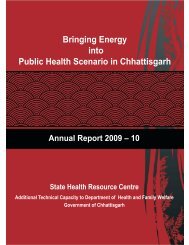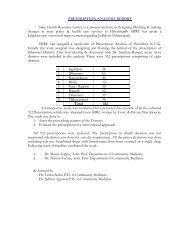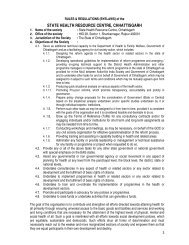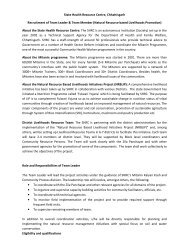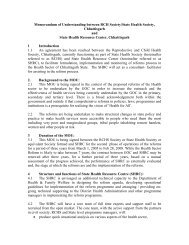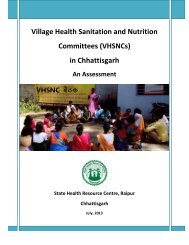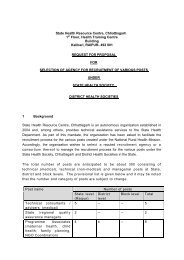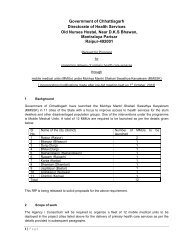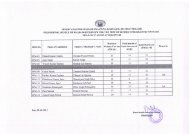ChhattisgarhHealthIn.. - State Health Resource Centre, Chhattisgarh
ChhattisgarhHealthIn.. - State Health Resource Centre, Chhattisgarh
ChhattisgarhHealthIn.. - State Health Resource Centre, Chhattisgarh
Create successful ePaper yourself
Turn your PDF publications into a flip-book with our unique Google optimized e-Paper software.
<strong>Health</strong> Insurance Plan Proposed for the <strong>State</strong> of <strong>Chhattisgarh</strong>DRAFT PROPOSALObjective:The objective of the Comprehensive health insurance policy is to provide health careservices to the entire population, in the form ofa) A Re-imbursement of medical expenses arising out of disease /accident necessitatinghospitalization,b) A Personal accident cover andc) Provision for providing sustenance (sustainability) allowance to individuals in the agegroup 18-60 temporarily disabled or rendered unable to pursue employment due todisease or injury to self or dependents. This would only be for care in public sectorundertakings.The policy proposed shall be defined by its exclusions and is a modification of theUniversal <strong>Health</strong> Insurance scheme.Sum assured and benefitsAge Group: 3 months to 65 yearsFor the age group below 3 months and above 65 years separate insurance policies wouldhave to be considered later.The policy envisages five sections as under:Section-I : Hospitalization expenses in the private sector.Section II: Hospitalisation expenses in the public sector- including “domestichospitalisation.”Section III : Sustenance expenses( only in the public sector).Section-IV : Accident Insurance to the head of the familySection-V: Special severe road accident trauma careSection –I Hospitalization expensesSum insured: Rs.30000 per annum. --to float over the family or individual towardshospitalization expenses.In the event of a claim becoming admissible under the insurance policy the insurer shallreimburse expenses incurred under the following heads:1.Room and boarding expenses2.Surgeon, Anaesthetic, Medical Practitioner, consultants, specialists fees, nursingexpenses.3. Costs of drugs and diagnostics3.Anaesthesia, Blood, oxygen, chemotherapy, cost organs, artificial limbs & other suchexpenses directly related to the treatment of disease/injury.The policy shall not cover:1.Congenital disease1
2. Injury /disease directly /indirectly caused or attributable to war invasion act of foreignenemy etc whether war is declared or not.3.All expenses related to treatment of HIV4.Charges at nursing home incurred for diagnostic studies that are not consistent with orincidental to the diagnosis and treatment of positive existence of any ailment, sicknessinjury.5.Expenses on vitamins and tonics and other drugs not on <strong>Chhattisgarh</strong> essential drug list- unless forming treatment of sickness/injury- certified separately.6.Circumcision unless necessary for treatment of a disease.7.Convalescence, debility, intentional self-injury, use of drugs and alcohol.8.Medical expenses incurred towards pregnancy and childbirth except caesarean sectionor treatment of eclampsia or near eclampsia.9. Cost of spectacles and contact lenses, hearing aids.10. Mental illness.11 General Medical check ups.12 Domestic hospitalization on account of general weakness or non localized body achesand pains.( see note on domestic hospitalization)The policy shall include:All pre-existing diseases- when treated in public sector hospital.All domiciliary hospitalization upto 7days- when treated in public sector hospital.All domestic hospitalization upto 28 days whether treated in public or private hospital ifdue to multiple bone fracture or lower limb fracture.All cases of surgeries upto limit of sum assured.All cases of cancers upto limit of sum assured.All other illnessesSection-II Sustainability allowanceIf members in the age group 18-60 are hospitalized and a claim has been admittedunder section-I then sustainability allowance at the rate of Rs.100/- per day for amaximum period of 8 days shall be paid irrespective of employment status. For fracturesinvolving lower limb, pelvis or spine the cover shall extend for a maximum of 30 days.Section-III Personal Accident CoverIf the earning head of the family meets with an accident then the INS co. shall pay asunder:1. Death due to accident Rs.50000/-2. Permanent Total Disability due to accident Rs.50000/-3. Partial disability –loss of one limb/one eye-rs.25000/-Section-1V Major trauma CareIn the event of the insured member meeting with a severe road/works accidentNecessitating major orthopedic intervention the INS co. shall reimburse to the extent ofRs50000- to the nominated agency.2
A sum of Rs.100/-per day towards sustainability allowance shall be paid up to amaximum period of 60days.*Premium structure- Per annum.Particulars Individual Family of 1+4 Family 1+6BPLRs.65(personal)+300(subsidy)Rs.248(personal)+300(subsidy)Rs.430(personal)+300( subsidy)Others Rs.365/- Rs.548/- Rs.730/-• The premium outgo is indicative and can be firmed up by the insurancecompanies once the parameters are fixed.• For BPL families free full payment of premium by Govt. with reimbursement togovernment of Rs 65 by the beneficiary.• For others Co-payment: Government contribution after registration and paymentby the beneficiary.• Note that the premium shown is indicative and to be used for understanding theapproximate costs. Exact premium would be decided by tendering and lowestquote. Alternatively- it can be agreed that the claims ration to total premiumcollected would be 80%. If the claims are more and administration has beenadequate then the premiums would be revised upwards in the next year. If theclaims are less then the maximum permissible claims to premium ration wouldstill be 75% and this would be also adjusted in revising the next years premiumdownwards. There is therefore no question of maximizing profits by strictersanction of claims and in return no risks beyond a certain range in the first year.The insurer can maximize profits only by increasing the volume of business.Payment ModeFor the scheme to be user friendly the payment mode or mechanism of two types areenvisaged:Public sector hospitals – Here per disease /surgery freezing of upper limits can bedone away with. All diseases managed at the hospital will be covered. The hospitalwill provide a list of what are the conditions that it provides treatment for when it isregistered with the scheme.The Jeevan-Deep Samitis become the service providers who in turn get reimbursed bythe Insurance company. They would pay the cost of drugs that need to be purchasedlocally from Jeevandeep funds- over and above government supply. They would alsopay costs of surgeons or specialists who have to be brought in where needed. Plusthey would pay sustenance expenses to hospitalized person. They would submitaccounts quarterly and get reimbursed.Every Jeevandeep samiti would have one accountant trained for this purpose. Thecost of the training would be borne by the insurance company. Only after registrationwith the company and the training would the hospital become eligible.3
Private sector hospitals-Only accredited hospitals would be included.All accredited hospitals would sign an MOU.When the patient comes they can check with regional office whether the patient hassum assured to his name and then extend a cash less facility. For the first 48 hours orupto Rs 3000 unless it is life-saving they can start treatment even if not checked andthey would be eligible for reimbursement.The hospital can submit its claims for reimbursement to the regional insurancescheme project office and get reimbursed – once every quarter. In special cases –where it is a not for profit hospital or a start up clinic at the discretion of the insurersthis can be relaxed to monthly. The hospital will have to state all that it has chargedthe patient when seeking reimbursement- including what the patient paid out ofpocket.For every service there would be a fixed package cost. The hospital is free to spendmore or less than what it would get as part of the package. But it cannot pass onexcess costs to the patient – in any form.The list of procedures, surgeries and hospitalizations for which the patient is eligibleis specified and for each there is a reimbursable cost.All charges needed for treatment would be reimbursed but no sustenance chargeswould be admissible.Monitoring Mechanisms:a) Community Monitoring Mechanisms:a. All beneficiaries would be members of self help groups.b. The self help group would make the payment to the government for theBPL family- thus reimbursing the payment to the insurance company thatthe government has already made.c. The self help group would monitor to see that there is no false use of thescheme and also report any double –charging or perception of unfair care,refusal of care etc.d. The ASHA in the place would be trained to facilitate all the above – shewould ensure that the women make their contribution, that they are notcharged, and that they are provided basic quality of care. For this theywould get Rs 25 per family of five per year, that they enrol or are enrolledin an area under their supervision. This would be deducted from thepremium as insurance collection commission and monitoring support fee.b) Supervisory Monitoring: In addition to this 10% of the beneficiaries would be metat home by an NGO/ agency appointed a s monitor. They would check that thereis no double charging or false reporting. The hospitals would make the list ofbeneficiaries and payments made available to the monitors and they would cross –check this with the patient. There would be a fixed fee per cross-check made anda percentage of the recovered amount from a false claim paid as incentive.c) <strong>State</strong>- Level Supervision: In addition 2% of the beneficiaries would be crosscheckedby a state level agency and if the claims are false and the monitoringNGO has failed to report them, not only would they be penalized – after the third4
such error the contract would be terminated. The supervisory agency would bepaid over 50% of the claims so recovered as incentive.d) The hospitals shall maintain records to standards necessary to make such crosschecks.We expect that as result most commercial hospitals may not join. Which is alright inthe first few years for many not for profit and trust hospitals would join and thiswould favour the public sector hospitals to improve utilization. It would alsoeffectively reach out to the poorest. After this when we know the cost better and thescheme is viable we can modify it when needed.Cost to be borne by the state government:a) Cost of one accountant in every CHC and district hospital jeevan deep samiti,b) Cost of monitoring paid as grant amount.c) Cost of running six regional insurance scheme centers for administeringschemed) Cost of insuring all BPL which it would recover from the groups- this istherefore and advance .The first ( accountant in Jeevandeep samiti)would be incurred directly by it andthe rest would be paid to the insurance company as a grant amount in the first yearand by marking up premium rates accordingly in the second year.Cost to be borne by central government:Rs 300 per BPL family who enrolls.Explanatory Note:This scheme combines the advantages of the Karuna trust model , the Yeshwasinimodel the Kudumbasree approach and the ULIP model. It also builds on all thestrengths of the <strong>Chhattisgarh</strong> model:A comparative table is given below.Compensationfor accidentdeath/injuryCompensationfor fulldisabilityCompensationfor partialdisabilityTotal medicalexpenses for afamilyKaruna Yeshwasini Kudumbasree ULIP Proposed CGmodelNil Nil 100,000 25,000 50,000Nil Nil 1 lakh Nil 50,000Nil Nil 50,000 Nil 25,000Rs 2500per yearAny amount– but onlyfor one of1400 listedsurgeries30000 30,000 30,0005
Paymentmade toSustenancepaymentsDomiciliaryhospitalizationMaternitybenefitsAmbulancecostsPre-existingillnessincludedSpecificexclusions tonoteInvolvementof communityIs care inpublic sectorhospitaleligibleIs care inprivate sectoreligiblePremiumtotal- forfamily of five<strong>Centre</strong>subsidy<strong>State</strong>contributionHospital– Rs 50/dayRs 50 perday toindividualHospital Hospital Individualreimbursement- Cashless ifthrough TPANil Rs 100 per NildayNo No Yes: Max.Rs. 6000 peryear?Yes No Yes- exceptfor first 3months ofhospitalRs 100 perday forpublic sectorcare- uptomax of 7000except inortho.Nil 6000- forpublic sectorcareNil Only forsurgeryperiodYes No Yes No Only forpublic sectorhospitalYes No? Yes Nil Yes- but onlyfor publicsector care.Nil Everything Almost nil Mental Illness, MentalexcludedHIVillness , HIVexcept listof1400surgeriesSHGs Cooperatives SHGs Nil SHGsYes- onlyfor publicsectorNoYes- but nopreference -No Yes Yes- at least15 bedsYes – but nopreferenceYes? 600 399 548 548Yes – withpreferenceYes – withmore limitedpackage.? Now asked 300 300 300for? 150 Rs 33 local Nil ( advance+ Loss amountbody; small upto Rs 10administrative crores if6
BPLOnly forBPLbasedoncardIncluded –no specialpreferenceIdentified byspecialcriteriagrant for firstyear)Based on BPLcardAPL Excluded. Included Excluded Included buthave to pay Rs300 more thanBPLClaims Ratio ? Over 100% Not yet Good?need Rs 26 launchedcrores to Rs100 croresbail outcompensationexceedspremiumsrulesto befixedIdentified bymembershipto SHG pluscriteria/orcardIncluded buthave to payRs 300 morethan BPL-Goal shouldbe 80 to 85%of totalpremiumsThe German AID angle :We can make this scheme even more attractive by packaging some elements thatwe cannot charge the insurance company for fear of making it unviable but coulduse to make the programme more attractive and useful.German aid need only givea) technical assistanceb) Reimburse treatment for HIV patients as part of the insurance package andc) hamlet level treatment costs by Mitanins as part of building up sustainabilityfor the Mitanin Programme and linking it to the insurance scheme – i.e theypay for the drug kit and its distribution mechanism. The Mitaninsact ascollectors of premium and monitors of proper reimbursement like anyinsurance agents.d) Can also give a grant to SHGs that they would use as a revolving fund for riskpooling towards invisible costs of care which are not covered in the abovescheme.e) Can pay for an accountant and a organizer in every Jeevandeep samiti –reimbursement – who maintains the accounts of the Samiti, helps inimplement the scheme and collect payments from the insurance company7




